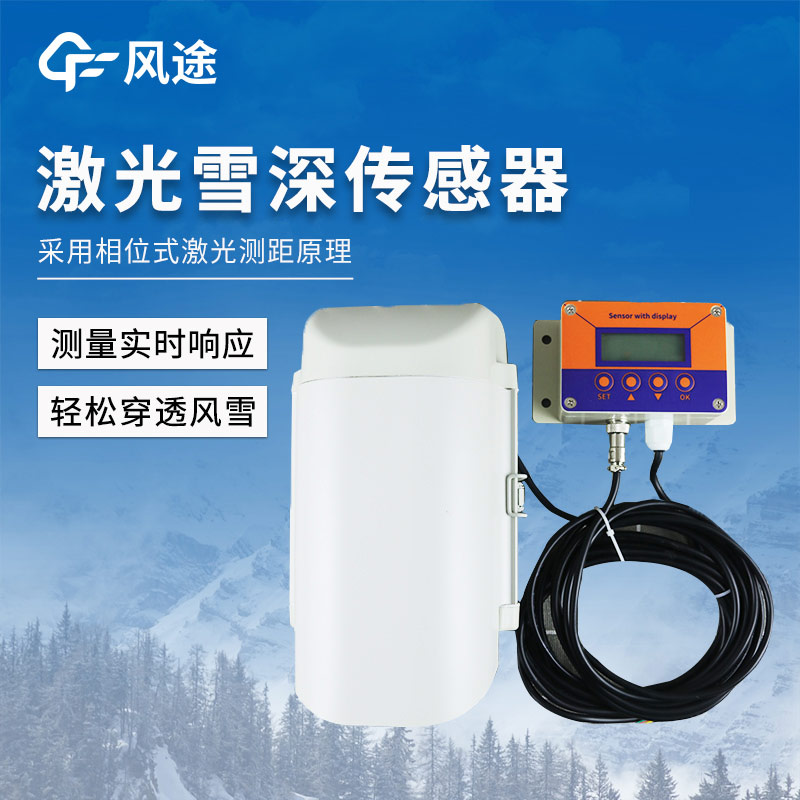Tianqiong Sensor IOT Technology Co., Ltd
Sales Manager:Ms. Emily Wang
Cel,Whatsapp,Wechat:+86 15898932201
Email:info@fengtutec.com
Add:No. 155 Optoelectronic Industry Accelerator, Gaoxin District, Weifang, Shandong, China

Sales Manager:Ms. Emily Wang
Cel,Whatsapp,Wechat:+86 15898932201
Email:info@fengtutec.com
Add:No. 155 Optoelectronic Industry Accelerator, Gaoxin District, Weifang, Shandong, China
time:2025-07-22 08:58:48 source:Weather Station viewed:245 time
In the road traffic environment safety monitoring system, the Laser Snow Depth Monitor, especially in areas with frequent snowfall in winter, can accurately and real-time monitor the depth of snow on the road surface. It provides key data for traffic management departments, helping to ensure road safety and smooth flow.
The Laser Snow Depth Monitor mainly works based on the principle of laser ranging. The device emits a laser beam to the road surface. When the laser beam hits the snow surface, part of the light is reflected back to the sensor. The sensor accurately measures the time difference between the emission of the laser and the reception of the reflected light. Combined with the known constant of the speed of light, it can accurately calculate the distance between the sensor and the snow surface. Since the installation height of the sensor is fixed, real-time snow depth data can be obtained through simple mathematical operations. For example, after a certain type of sensor emits a laser, it receives the reflected light in a very short time. It is calculated that the distance between the sensor and the snow surface is 2 meters, and the known installation height of the sensor is 3 meters, so the current snow depth is 1 meter.
Regarding the advantages of this sensor, first of all, it has high precision, with a measurement accuracy of up to the millimeter level, which can accurately reflect subtle changes in snow depth and provide accurate data support for traffic decision-making. Secondly, it has strong real-time performance. It can continuously monitor snow depth without interruption, quickly collect and transmit data at set time intervals (such as every minute), so that traffic management departments can keep abreast of snow conditions at any time. Finally, it has excellent ability to adapt to harsh environments. It can work stably in harsh weather conditions such as low temperature, strong wind, and heavy snow, ensuring the continuity and reliability of data.
On expressways, management departments use sensor data to timely judge road snow conditions. When the snow depth reaches a certain level, they can start snow removal emergency plans in advance and rationally deploy equipment such as snowplows and snow-melting agent spreaders to ensure driving safety on expressways.
Especially for mountain roads, due to complex terrain and changeable climate, snow has a greater impact on traffic. The sensor can monitor in real time, helping relevant departments to issue early warnings and take measures such as road closure and traffic restriction when necessary to avoid traffic accidents.
In cities, municipal departments reasonably arrange the order of snow removal operations according to the feedback from sensors, giving priority to clearing key sections such as main roads, bridges, and steep slopes, so as to improve snow removal efficiency and reduce the impact of snow on citizens' travel.

To measure water levels, a Radar Water Level Sensor is required, such as the YW-76 introduced today. Let's take an in-depth look at its advantages and working principle.1. High-frequency Technology Ensures Measurement AccuracyThe YW-76 horn-type Radar Water Level Sensor adopts Frequency Modulate...
Since its establishment, TianQiong has been focusing on the research and development, production, sales, and service of hydrometeorological equipment. Relying on a complete production chain and a professional technical team, it has developed rapidly in the industry.TianQiong offers a rich variety of...
Wind speed monitoring is not only crucial for the promotion of a green lifestyle but also directly affects our daily travel safety and the production environment. When the wind speed is too high, it not only poses a threat to driving safety but may also trigger natural disasters. Therefore, the prec...
China has a vast territory with complex and diverse geographical environments and significant differences in climatic conditions. As a crucial link for power transmission, transmission lines inevitably traverse special geographical areas such as valleys, high - altitude peaks, and rivers. These spec...